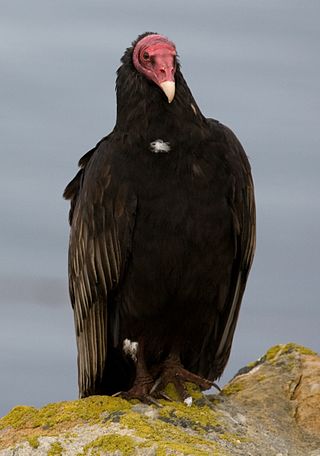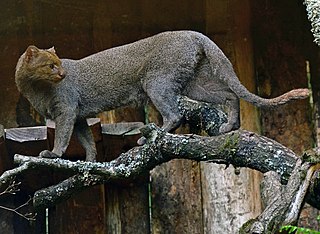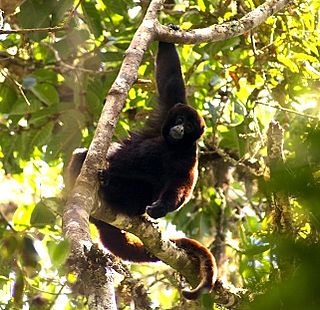
The jaguar is a large cat species and the only living member of the genus Panthera native to the Americas. With a body length of up to 1.85 m and a weight of up to 158 kg (348 lb), it is the largest cat species in the Americas and the third largest in the world. Its distinctively marked coat features pale yellow to tan colored fur covered by spots that transition to rosettes on the sides, although a melanistic black coat appears in some individuals. The jaguar's powerful bite allows it to pierce the carapaces of turtles and tortoises, and to employ an unusual killing method: it bites directly through the skull of mammalian prey between the ears to deliver a fatal blow to the brain.

The New World vulture or condor family, Cathartidae, contains seven extant species in five genera. It includes five extant vultures and two extant condors found in warm and temperate areas of the Americas. The "New World" vultures were widespread in both the Old World and North America during the Neogene.

The jaguarundi is a wild cat native to the Americas. Its range extends from central Argentina in the south to northern Mexico, through Central and South America east of the Andes. The jaguarundi is a medium-sized cat of slender build. Its coloration is uniform with two color morphs, gray and red. It has an elongated body, with relatively short legs, a small, narrow head, small, round ears, a short snout, and a long tail, resembling mustelids in these respects. It is about twice as large as a domestic cat, reaching nearly 360 mm (14 in) at the shoulder, and weighs 3.5–7 kg (7.7–15.4 lb).

The yellow-tailed woolly monkey is a New World monkey endemic to Peru. It is a rare primate species found only in the Peruvian Andes, in the departments of Amazonas and San Martin, as well as bordering areas of La Libertad, Huánuco, and Loreto.
The golden Oldfield mouse or golden thomasomys is a species of rodent in the family Cricetidae. It is found in Colombia, Ecuador, Peru, and Venezuela. Both the common and genus name commemorate the British zoologist Oldfield Thomas who worked at the Natural History Museum, London and studied South American rodents.

Thomasomys is a genus of rodent in the family Cricetidae, named after British zoologist Oldfield Thomas. Nuclear DNA sequence analysis has indicated that it is a sister taxon to Rhagomys. It contains the following species:
Daphne's Oldfield mouse is a species of rodent in the family Cricetidae. It is found in Bolivia and Peru.
The Peruvian Oldfield mouse is a species of rodent in the family Cricetidae. It is found only in Peru.
The slender Oldfield mouse is a species of rodent in the family Cricetidae. It is found in Ecuador and Peru.
Kalinowski's Oldfield mouse is a species of rodent in the family Cricetidae. It is found only in Peru.
The distinguished Oldfield mouse is a species of rodent in the family Cricetidae. It is found only in Peru.
Thomas's Oldfield mouse is a species of rodent in the family Cricetidae.
Rosalinda's Oldfield mouse is a species of rodent in the family Cricetidae. It is found only in Peru.
Taczanowski's Oldfield mouse is a species of rodent in the family Cricetidae. It is found only in Peru.
The white-tipped Oldfield mouse is a species of rodent in the family Cricetidae. It is found in the Andes from central Ecuador to northern Peru, at elevations from 2500 to 3350 m, where it lives in montane forest.
The wandering Oldfield mouse, also called the wandering thomasomys, is a species of rodent in the family Cricetidae. It has been found in both the Cordillera Oriental and Cordillera Occidental of the Andes in central and north central Ecuador, at elevations from 2400 to 3600 m. It has terrestrial habits, and has been found in cloud forest and areas of secondary vegetation. It was formerly considered a subspecies of T. cinereiventer.
The large-eared Oldfield mouse is a species of rodent in the family Cricetidae. It is known only from a single locality in the Andes in north central Peru, in montane forest at an elevation of 3300 m. It has terrestrial habits and is sympatric with T. apeco.
The Ashaninka Oldfield mouse is a species of rodent in the family Cricetidae. It is known only from a single locality in the Cordillera Oriental of the southern Peruvian Andes, in montane forest at an elevation of 3350 m. It has terrestrial habits. The common name refers to the Asháninka, the largest indigenous group of the Peruvian Amazon.
The Cajamarca Oldfield mouse is a species of rodent in the family Cricetidae. It is present in the Andes of northwestern Peru, where its habitats include shrubby páramo, montane forest, and secondary forest. The rodent is nocturnal and may be partly arboreal. It was formerly considered a subspecies of T. aureus. The common name comes from the Peruvian city and region of Cajamarca.

Thomasomys ucucha, also known as the ucucha thomasomys, is a rodent in the genus Thomasomys of the family Cricetidae. It is known only from high altitude forest and grassland habitats in the Cordillera Oriental of Ecuador. Seven other species of Thomasomys live in the same areas. First collected in 1903, T. ucucha was formally described as a new species in 2003 and most closely resembles T. hylophilus, which occurs further to the north. The species is listed as "vulnerable" in the IUCN Red List as a result of habitat destruction.






